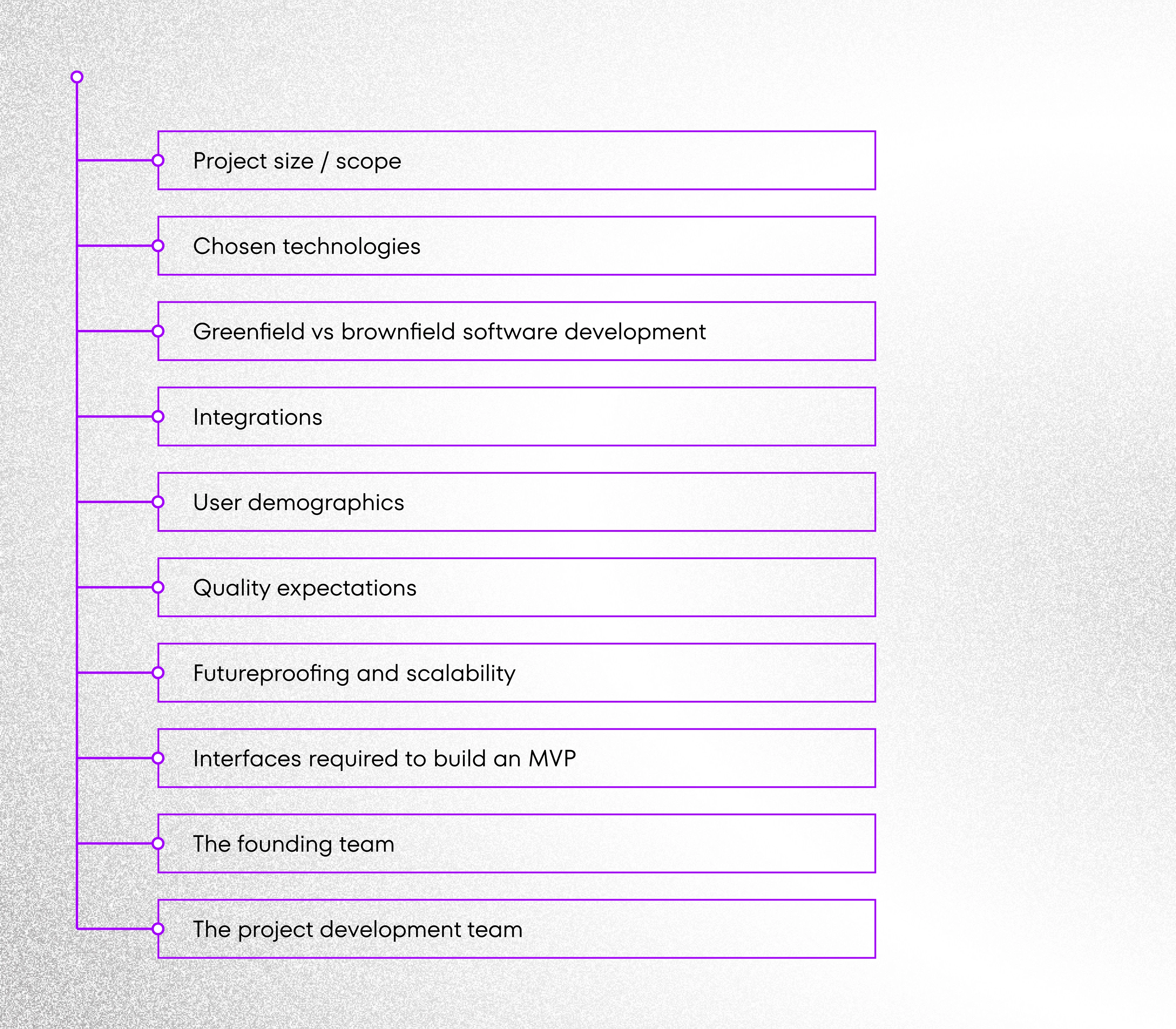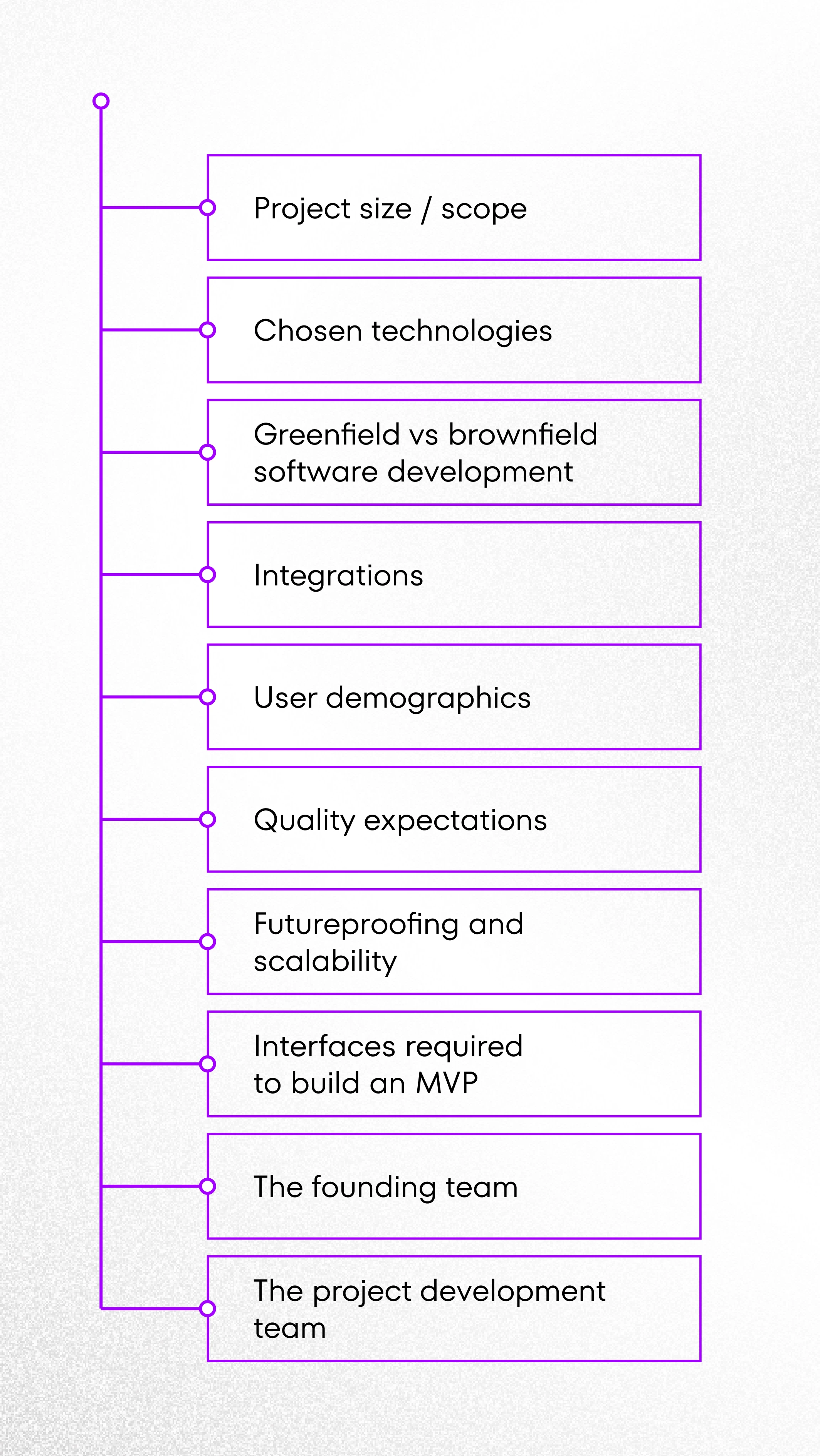April 2nd, 2021 | by Michał Gorski
MVP Price - How Much Does It Cost to Build an MVP and Why?

Table of contents
You have a groundbreaking idea. You’re probably wondering whether it’s going to be a hit.
The best way to test it? A minimum viable product (MVP).
A crucial question is: how much does it cost to build an MVP? Obviously, the price is dependent on several factors. But I can tell you right away it’s relatively cheap compared to the actual product.
What you’ll learn from this article?
- What is an MVP? First things first, I’ll give you a short definition of an MVP.
- How much does it cost to build an MVP? I’ll provide you with the exact numbers based on CSHARK’s experience.
- What influences the MVP price? You’ll be armed with the knowledge of the cost’s determinants. And there are a lot of them!
- Partner team can be your way to success. You’ll know what to look for in a potential partner. A little hint: it could be us.
What is an MVP?
An MVP is a working, customer-facing version of your product in its earliest stages. The MVP should only contain the core features necessary to fulfill its primary purpose and nothing else. It helps reduce the price and accelerates the product development timeline.
Simply put, MVP is an effective way of collecting feedback that will influence your product’s final direction.
How much does it cost to build an MVP?
The cost of a minimum viable product can range from $40,000 to $120,000
Based on our 8 years of experience and estimating dozens of projects, we’ve found that the cost of MVP development can range from $40,000 to $120,000.
It’s spread across a timeline of several weeks to several months.
Let’s review the factors that influence MVP development cost and what makes up the final MVP price.
ARE YOU INTERESTED IN HOW MUCH YOUR MVP CAN COST?
FILL IN THE FORMWhat influences the MVP price?
The MVP cost can change dramatically from project to project. Some MVPs are complex, while others are simple and can be done quickly. I listed some of the more common influencing factors below.


1. MVP development project size/scope
It’s almost a no-brainer; the bigger a project will be, the more money it’s going to cost.
Did you notice that I said “project” and not MVP? That’s because the scope (a key part of every project) is going to dictate how large your MVP will be.
There’s no ready formula for reducing a project down to its minimum viable product. Instead, it boils down to “what’s the simplest we can make our product while still being able to fulfill its core function?”.
Read more: How to Build an Effective MVP in 15 steps
For example, you might envision a timekeeping app that integrates with different accounting software, sends notifications, and generates valuable reports. Your MVP may focus exclusively on capturing time entries – that’s the most valuable function for customers at this stage.
Let’s envision a different project: an accounting platform. The size of your MVP is going to be drastically different! The accounting software MVP needs a much wider set of functions to do its job, so it will cost a lot more.
2. MVP price vs. Chosen technologies
Your first consideration should always be whether your MVP will solve the user’s. Technology is the tool that you’ll use to build that solution.
Not all technologies are created equal. Some are better suited to certain situations than others and could affect your budget differently.
- Age
You want to work with technology that’s been around for a while, like ASP.NET Core or React. Established technologies tend to be more stable. More developers can work with them than the “trendier” technologies.
- Relevance
Age isn’t everything! COBOL is an old, established technology, but you wouldn’t want to be caught dead using it in your MVP. Using legacy tech without a good reason will drive your development costs sky-high. And all this without any corresponding benefit…
Stick to simple rules. Choose technologies that are still being used to develop new applications. And avoid those that are becoming less common.
- Who’s backing it
Does the technology you’re using have significant support behind it? ASP.NET Core is being backed by Microsoft, and Angular.js is being backed by Google. Even Node.js, which doesn’t have a company behind it, still has a large community of users. These backers will provide the support and resources necessary to work with the technology efficiently. Also, technology with lots of backing is more likely to be around in 5 years, so you won’t have to switch technologies mid-stream.
- Workforce costs
Developer rates differ depending on the tech stack they specialize in. For example, developers in common programming languages tend to be reasonably priced, but those who work with niche tech stacks come at a higher cost.
For instance, according to the “These are the highest paying developer skills and occupations” research by Kristen Felicetti published on Monster.com, full-stack developers in the US who work with Redis and React earn an average of $105,000, while those who work with the Spark computer framework and Scala language bring in an average of $125,000.
Employment status affects salary ranges, too. The same Monster.com study shares that full-time developers make an average of $98,949, compared to self-employed developers with an average of $82,293.
3. Greenfield vs. brownfield software development cost
When you choose a car, there are no better or worse solutions. It all depends on your needs, context, and budget.
We also can’t say that greenfield is always better than brownfield, or vice versa.
Developers usually prefer greenfield projects because they can build the whole architecture from scratch. They’re in the process from the concept stage and know exactly what’s in their code.
On the other hand, it happens that the client already has a finished product. All the elements and features work, and to create an entirely new product, we only need to rearrange them and add some code. It’s then a more reasonable option.
It may be that brownfield software development will be more expensive. We have to start with an audit, a thorough check of the code, and verification of what’s in the grass. So it may turn out to be a more challenging option. Yet, if the changes aren’t too significant, it may turn out to be the right one.
While we can usually develop a greenfield MVP between $40,000-120,000, we happened to make a brownfield from $20,000. We always try to check what needs to be done meticulously and verify which solution will be better. Not for us, but for the client.
4. MVP price depends on the integrations costs
Integrating with existing software sounds easy on the surface.
After all, many SaaS applications do it all the time, and services like IFTTT and Zapier make it look easy. Integrations are a thorny topic for MVPs though, and for several reasons.
- Access to partner software
Many modern software products give development partners access to their code, documentation, or publicly released API. It allows other software to integrate with their platform. In these cases, integrations can be managed, and the risks can be predicted and understood before launch.
If these connections are unavailable, however, or the partner company isn’t cooperating, then these integrations may not even be possible, and the effort spent investigating it may be better used elsewhere.
- A number of integrations
How many integrations will be required for the MVP to be able to provide value? Can the integrations be taken individually, with some available upon release and others to follow in future versions? Or do all the integrations need to be available from the get-go?
The number of integrations will significantly impact your project’s timeline and cost. This will be compounded by their complexity and your access to the partner software. For best results, triage the integrations in your scope until you achieve the least number of integrations possible.
- The complexity of integrations
It isn’t just the number of integrations that matters; it’s their complexity.
Simple integrations that only involve a transfer of data are easy to pull off and won’t add much to the MVP cost at all. But if the interaction requires conditional logic or cascading actions, then that jacks up the potential costs considerably… The same goes for two-way integrations requiring live or regular connections between the two platforms.
If you want to reduce your MVP’s cost, simplify the relationship between the two programs. Perhaps your house team can discover a way to reduce integration complexity, either by interacting with the partner software in other ways or modifying the product’s functionality. For example, you can work with a one-way integration first and upgrade it to a two-way integration later on.
5. User demographics
What industry is the product being built for? Who will be the end-users of your MVP? How big of a user base are you expecting?
These answers matter because they can impact your MVP’s overall cost.
If you’re building a HealthTech application, for instance, you will need to ensure that your MVP is FDA, HIPAA, or GDPR-compliant.
Suppose you’re creating an MVP for the financial industry, retail, or anything else that processes transactions. In that case, you may need to invest in tighter cybersecurity measures like encryption and two-factor authentication. In addition, different industries may require different standards in the way your MVP is built.
If you’re expecting a lot of users, you’ll want to optimize your MVP in such a way that it can handle that much traffic. There are documented incidents of products that have been launched to great fanfare, only for the product to crash because the company underestimated the demand on the servers…
Also, look into any special considerations that your users will need. For example, products with an international target audience may require regional-friendly features such as language settings.

Your UX design should be as simple and streamlined as possible, and this becomes even more important if you know that your target audience isn’t comfortable with technology, like in the case of seniors.
Your technology partner will be able to guide you through the step-by-step process of identifying your user’s particular needs and solving them.
Read more: The UX Design Strategy in the Software Development Process
6. Quality expectations
Quality is a process, not destination.
No software will ever be completely bug-free.
You’ll have to decide how much effort you’ll be putting into squashing those bugs. Do you only fix the major app-breaking ones and leave the rest for future updates? This will have the advantage of reducing your timeline and labor cost and also will help you get to market faster but carries the risk of annoying the target audience.
On the other hand, you could put your best foot forward and address as many bugs as possible. Of course, it’s more expensive and takes a longer time to execute. But your users will have a more seamless experience and will (hopefully) leave with a good impression.
Remember that “quality” doesn’t just refer to bugs! It also refers to how much attention you give to the user experience design – things like being able to conveniently switch from one section of your app to another, or send notifications when major events occur.
Quality-of-life additions will go a long way toward getting users to love your product. They could also be considered a luxury depending on your MVP cost and timeline.
7. Futureproofing and scalability
When you’re creating an MVP, you’re not just creating it to solve current needs. It’s a forward-looking product that needs room to grow.
Your MVP should have as simple a design as possible. It should have a responsive layout and run properly on multiple devices and platforms. We described a few factors you should know before starting the creation of your MVP in the article “MVP Software Development – How to Succeed at Creating Digital Products?“.
Using proper software development design principles may require more up-front work, which will pay dividends in the long run. Software that is easy to maintain and modify will improve your scalability when you move past the MVP stage.
Your project team will have to choose between a monolithic architecture or a microservices architecture.
A monolithic architecture is when different components are brought together as a single program or platform. Most monolithic applications can handle relatively high traffic and are used by many existing software projects. However, monolith applications can be challenging to scale. In addition, the larger and more complex a monolithic application is, the more difficult it is to make quick updates.
Microservice architecture is built as a collection of modular services. Each module solves a specific business goal and is connected to other modules using an interface designed for the purpose. The microservice architecture is a better long-term option – individual modules can be swapped or updated as the need arises. They can also be scaled separately.
8. Interfaces required to build an MVP
How will your target audience use your solution? Should your MVP be usable across multiple devices, or it’s fine to go with a simple web interface?
Of course, the more devices you want to cover, the higher the MVP development price will be. You have a few paths to choose from:
Classic Web App
All you need to worry about is how your MVP looks in a web browser – and only a web browser on a computer.
Responsive Web Design (RWD)
If you’re going to apply RWD, you need to decide that ahead of time. It requires the code to be written using specific methods like the Bootstrap framework. The MVP can have an easily adjustable screen resolution across multiple device types: mobile, tablets, and web. Suddenly switching to RWD in mid-project will be expensive since you’ll have to rework the frontend.
Progressive Web Application (PWA)
A progressive web application framework ensures that your MVP will run on any standards-compliant browser. It contains elements of the RWD framework but has other capabilities such as running without an Internet connection, opening via a desktop icon, push notifications, and stricter data safety requirements.
Native Mobile App or Hybrid Apps
It’s also possible to build an app that your user downloads on the phone via the Google Play Store or App Store. A native app is developed for each system separately (the most common are iOS and Android). With hybrid solutions based on React Native framework, we can create a mobile app for both systems at once.
Each solution has its pros and cons, depending on the user’s needs and conditions. Fortunately, you don’t have to decide – it’s worth having a technology partner do it with you.
9. The founding team
Founding teams are an essential source of domain knowledge and expertise but, depending on the team’s composition, may not be as vital in product development.
Therefore it’s better to find a partner with experience in software and product development for the best results. Together, the founding team and the development partner will leverage the best qualities of both parties and build a value-rich and cost-efficient MVP.
10. The project development team
There’s no single correct way to staff your house team; your project team composition is going to depend on multiple factors. This, of course, also affects the final MVP price.
Team size and structure
How large are you expecting your MVP development team to be? Are you going to have a large org chart broken down into smaller sub-groups, or will you be operating with a smaller, leaner team?
The larger your pool of resources, the more you can get done, but that also means you burn cash faster. You’ll need systems in place to make sure they’re working efficiently and someone to manage those systems. That’s another mouth you’ll have to feed.
A minor team will use up less cash per month, but the project may end up taking longer as a result. However, the trade-off inefficiency might just be able to compensate for the lengthier timeline.
So which is better? According to “Faster and leaner: the trend toward smaller software development teams” research done by Aileen Horgan published on atlassian.com blog, smaller development organizations of 1-100 members push projects to production faster. The study credits this to smaller teams having simpler processes with fewer cross-team dependencies.
Experience
Highly experienced developers cost more, which is why you don’t want a team composed entirely of senior developers. Instead, a team of younger, newer developers led by a single or a few highly experienced senior developers will be the most cost-effective arrangement for your project.
Skill/expertise
The scarcer or more demanding skill is, the higher the developer’s asking price will be. For instance, blockchain developers are relatively rare and can easily pull a six-figure annual salary compared to web developers who can be hired for a fraction of that cost.
To minimize this expense, use popular or established technologies to build your MVP. Then, you’ll be able to choose from a wider pool of developers and have room to negotiate salaries if needed.
Partner team as your way to success
Two numbers truly determine how much MVP development costs: hours spent and hourly rates.
All of the other conditions I mentioned in the article above modify one or both of these numbers. Want a better-quality product? Spend more hours. Want developers that know what they’re doing? Pay your developers more.
Another way you can help control the cost of MVP is by working with a partner company with a software development team already in place. These partner teams are often composed of developers with experience in a wide range of projects. They have a diverse collection of skills, which makes it more cost-effective to hire them as a group rather than assemble an internal team from scratch.
Partner teams like ours have built dozens of MVPs and know how to estimate them. We can also advise you when it comes to evaluating feature sets, UX and UI design, and technology.
Reach out, so we’ll be able to provide you with no-nonsense feedback on your project’s timeline, MVP cost, and feasibility.


